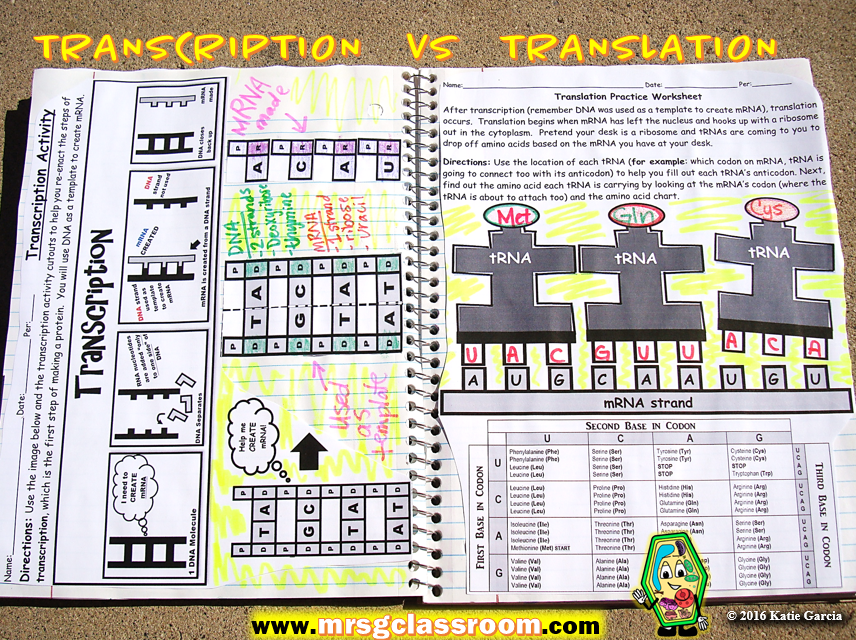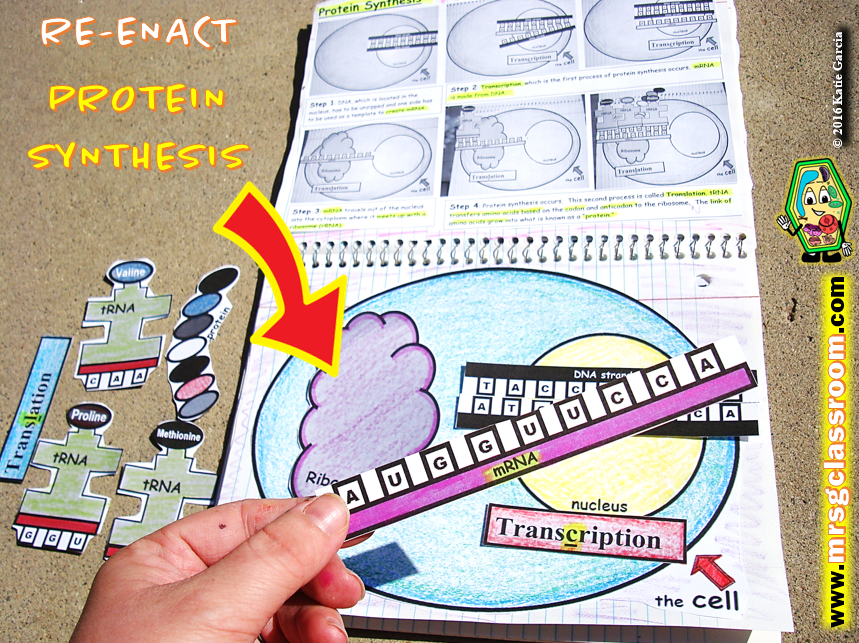Protein synthesis is one of the hardest topics to cover in biology. I realized this when I started teaching it my first year. So I wanted to create worksheets that are very visually appealing, hands on, interactive, and detailed. I think it is important to break up the steps of protein synthesis as well. You should have a few worksheets about transcription and a few about translation. Then a worksheet or activity combining both steps. I feel like my protein synthesis bundle has these types of worksheets/foldables/activities in it.
Just like my DNA Bundle, my RNA bundle has
- Teacher notes
- Student notes
- PowerPoint Notes
- Interactive Activities/Worksheets/Foldable(s)
- Homework
- Quiz
Here are some of the worksheets that I have in my bundle.
PROTEIN SYNTHESIS – How to Make a Protein
STEP 1: TRANSCRIPTION

(IMAGE ABOVE) I noticed that many worksheets had a DNA strand like this, “ATGCAT,” and would ask students to write the appropriate letters that mRNA would have if this DNA strand was used to make it. It just wasn’t enough for me. I wanted something more visual, so that is why I created my worksheet. You can see that I start by explaining the first step of protein synthesis which is transcription. Then I give students a image showing DNA unzipping. I explain to my students just imagine transcription happening — the DNA unzips and one strand is used to make mRNA. You can see that I give students three DNA strands and they have to make 3 mRNA strands from each DNA. I noticed that in other worksheets, students couldn’t tell what letter they are under and this worksheet makes it easy to see what letter you are under and plenty of room to write the letter.

(IMAGE ABOVE) This next worksheet has students use a image as a guide to help them re-enact the steps of transcription. You will see that students have to help the DNA create mRNA. Students will be given the DNA strand and mRNA nucleotides. Students will cut out the DNA and separate the two DNA strands (just like when the DNA unzips) then use the left side of DNA as a template to create mRNA (just like the image shows them at the top of the page of the worksheet). Then after they create mRNA, they will close the DNA strand back up and glue it onto the page along with the new mRNA strand. You can see that I also had students label the strand of DNA that was used as a template, the mRNA that was made, and I had them write the differences between a DNA and mRNA molecule.
STEP 2: TRANSLATION

(IMAGE ABOVE) This next worksheet starts by explaining what happens during translation and has students fill in the anticodon for each tRNA. Then students have to figure out the amino acid the tRNA is carrying. Now students can start to see how a protein is built. Now we need students to actually physically build a protein to really grasp this difficult concept.

(IMAGE ABOVE) I like having students put the 1st step of protein synthesis, which is transcription, on the left side, and the second step, translation, on the right side. Students can refer back to this section in their notebook to recall the difference between the steps.

(IMAGE ABOVE) Now, like I mentioned before….”we need students to actually physically build a protein to really grasp this difficult concept.” So you can see that I give students a mRNA strand, and they have to figure out what tRNA they need. I have a page of tRNAs. They will look for the tRNA they need, cut it out, and then cut off the amino acid that it carries on top of it’s head. They will take that amino acid and glue it down on the page on the right that says, “Let’s Build a Protein.” They will continue this process until they finish making their protein.
(IMAGE ABOVE ON THE RIGHT) I also included two little foldables that asks students a question, and they will have to lift up the flap to see what the answer is. This just helps students recall/remember this activity.

(IMAGE ABOVE) This worksheet I created so students could have something to compare the process of protein synthesis too. When I teach this difficult concept, I tell my students, “when you make a cake, does it consist of just 1 ingredient?” They will say, “no.” Then I ask them “what ingredients could I find in a cake?” They start to name ingredients like, “milk, sugar, eggs… etc” and I mention how “a protein is also made up of many different ingredients, but it’s ingredients are different types of amino acids.” Students always have a hard time grasping the idea that a protein is made up of many amino acids just like cake is made up of many things as well. I feel that by comparing it to something they already know, like how to make a cake, they tend to remember the process of protein synthesis better.

(IMAGE ABOVE) I love foldables. They are a great way for students to quiz themselves later or even a friend. This foldable compares the 3 different types of RNA involved in protein synthesis and what their function/job is. Students can lift the flaps to see the answer.

(IMAGE ABOVE) This last activity has students bring together all of their knowledge and apply it. Here students re-enact protein synthesis. They start with transcription and then close with translation. They will use the paper cut-outs to re-enact how a protein is made. I also provided them with a worksheet above that serves as a guide to show them how to use the pieces to re-enact protein synthesis. Students can glue a envelope in their interactive notebook to keep the pieces together so they do not lose them. I don’t even have my students glue this activity in their notebook anymore. I print it all on cardstock and just pass it to students to practice. I have one student read the guide worksheet while the other student re-enacts the steps that their partner is reading. This activity also comes with questions. I place the questions (which is just a 1 page worksheet) in a sheet protector and give students a dry erase pen so they can write out the answers on the worksheet. If you want an idea of how this product works, here is a old youtube video demonstrating the product. Click here to see the video. I have updated the images/clipart since then.
If you would like to purchase my Protein Synthesis & RNA Bundle, click here.

